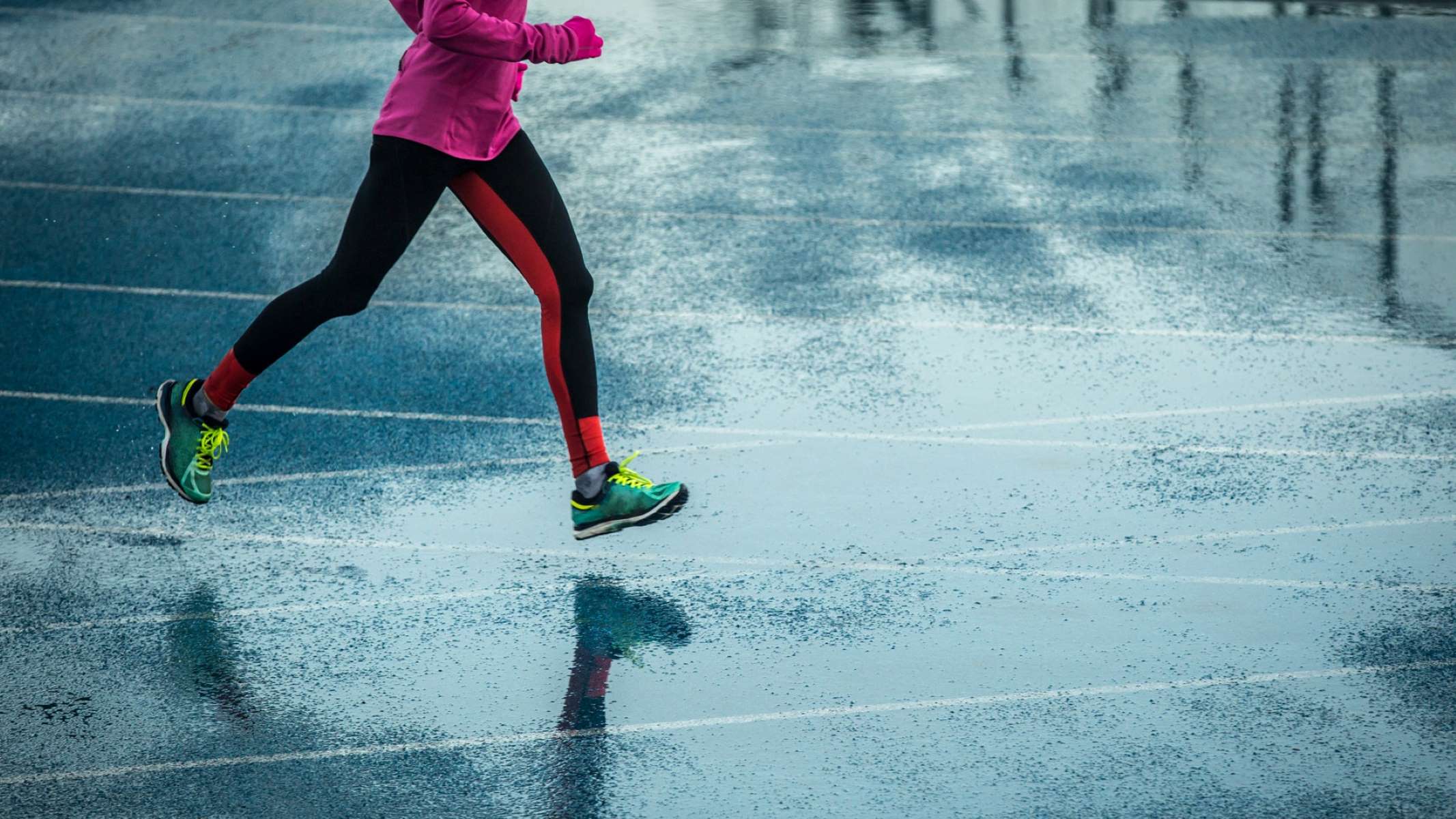Home>Gear & Reviews>Tips For Running In The Rain


Gear & Reviews
Tips For Running In The Rain
Published: February 20, 2024
Discover essential gear and reviews for running in the rain. Stay dry and comfortable with our expert tips and recommendations. Choose the best gear for a successful rainy run.
(Many of the links in this article redirect to a specific reviewed product. Your purchase of these products through affiliate links helps to generate commission for Therunningadvisor.com, at no extra cost. Learn more)
Table of Contents
Importance of Proper Gear
When it comes to running in the rain, having the right gear can make all the difference between a miserable experience and an invigorating workout. Proper gear not only keeps you comfortable but also helps prevent injuries and ensures that you can maintain your training routine regardless of the weather.
Read more: 9 Tips For Running In Costume
1. Waterproof and Breathable Clothing
Investing in waterproof and breathable clothing is essential for running in the rain. Look for running jackets and pants made from materials that repel water while allowing sweat to escape. This will keep you dry from the rain while preventing overheating and discomfort caused by trapped moisture.
2. Quality Footwear
Choosing the right footwear is crucial for running in wet conditions. Opt for running shoes with good traction and water-resistant features to prevent slipping and keep your feet dry. Additionally, wearing moisture-wicking socks can help prevent blisters and keep your feet comfortable throughout your run.
3. Headgear and Eyewear
Don't forget to protect your head and eyes. A waterproof hat or cap can keep rain out of your eyes and shield your face from the elements. Consider wearing a visor to help maintain visibility while allowing excess heat to escape. For those who wear glasses, investing in water-repellent or anti-fog eyewear can significantly improve visibility and comfort during rainy runs.
4. Reflective Gear
Visibility is crucial, especially in low-light and rainy conditions. Wearing reflective gear, such as a vest or bands, can make you more visible to drivers and other pedestrians, reducing the risk of accidents during your rainy runs.
5. Accessories
Carrying a waterproof phone pouch or using a waterproof armband can protect your electronic devices from water damage. Additionally, consider using a running belt or waist pack to keep your essentials dry and easily accessible during your run.
By prioritizing the right gear, you can ensure that running in the rain remains a safe and enjoyable experience. Proper gear not only protects you from the elements but also allows you to maintain your training routine without compromising your comfort and safety.
Preparing Your Route
When planning to run in the rain, preparing your route becomes a crucial aspect of ensuring a safe and enjoyable experience. Running in wet conditions presents unique challenges, and selecting the right route can significantly impact your overall run. Here are some essential tips for preparing your route for a rainy run:
-
Surface Selection: Opt for routes with stable and non-slip surfaces. Avoiding slippery paths, such as smooth concrete or marble, can help reduce the risk of falls and injuries. Instead, choose routes with textured surfaces, such as asphalt or gravel, which provide better traction in wet conditions.
-
Avoiding Flooded Areas: Heavy rain can lead to flooding in certain areas. When planning your route, steer clear of low-lying areas or regions prone to flooding. Running through flooded areas not only poses safety risks but also increases the likelihood of getting drenched, making the run less enjoyable.
-
Sheltered Paths: Look for routes that offer some form of natural shelter, such as tree-lined paths or urban areas with tall buildings. These features can provide partial protection from the rain, reducing the amount of direct exposure and helping to keep you relatively drier during your run.
-
Visibility Considerations: Assess the visibility along your chosen route, especially in rainy and low-light conditions. Opt for well-lit paths or areas with minimal traffic to ensure that you can see and be seen by others. Additionally, consider routes with fewer obstacles to minimize the risk of tripping or falling in the rain.
-
Drainage Assessment: Pay attention to the drainage systems along your route. Routes with proper drainage can help prevent water accumulation, reducing the likelihood of encountering large puddles or waterlogged areas. Avoiding standing water can help maintain your pace and prevent discomfort during your run.
-
Alternate Routes: It's beneficial to have a few alternate routes in mind in case your primary route becomes impassable due to heavy rain or flooding. Being prepared with alternative paths can ensure that you can still complete your run without having to navigate through unsafe or excessively wet areas.
By carefully preparing your route for running in the rain, you can mitigate potential hazards and enhance your overall running experience. Selecting a suitable route that prioritizes safety, visibility, and comfort can make a significant difference in how you navigate and enjoy your rainy run.
Adjusting Your Pace
Running in the rain necessitates a thoughtful approach to pace adjustment, as the wet conditions can significantly impact your running performance and overall experience. Adapting your pace to the rainy environment is crucial for maintaining safety, preventing injuries, and optimizing your workout. Here's how you can effectively adjust your pace when running in the rain:
1. Mindful Footing
The first aspect to consider when adjusting your pace in the rain is your footing. Wet surfaces can be slippery, increasing the risk of slips and falls. To counter this, it's essential to take shorter and more controlled steps. This adjustment allows for better traction and stability, reducing the likelihood of accidents and injuries. By maintaining a mindful footing, you can navigate the wet terrain with greater confidence and safety.
2. Moderate Speed
While it may be tempting to maintain your regular running speed, it's advisable to moderate your pace in the rain. The reduced traction and increased effort required to navigate wet surfaces can impact your overall speed. Slowing down slightly can help you maintain better control and stability, minimizing the risk of skidding or losing balance. By adjusting your speed to the conditions, you can ensure a more controlled and secure running experience.
3. Consistent Effort
Incorporating consistent effort into your rainy run is essential for managing energy expenditure and preventing fatigue. The adjustment here involves focusing on maintaining a steady effort level rather than fixating on maintaining a specific pace. This approach allows you to adapt to the varying terrain and weather conditions while ensuring that you can sustain your run comfortably. Consistent effort also reduces the likelihood of overexertion, promoting a more enjoyable and sustainable rainy run.
4. Mind Over Pace
Running in the rain often requires a shift in mindset from pace-focused running to a more mindful and adaptive approach. Instead of fixating on achieving a particular pace, prioritize running with heightened awareness of your surroundings and body movements. This shift in mindset enables you to respond to the changing conditions, adjust your pace intuitively, and make real-time decisions to ensure a safe and effective run.
5. Posture and Balance
Maintaining good posture and balance becomes even more critical when running in the rain. Adjusting your pace to focus on stable and controlled movements can help prevent slips and falls. Engaging your core muscles and keeping your body aligned can enhance stability and reduce the risk of injury. By prioritizing posture and balance, you can adapt your pace to promote a safer and more efficient rainy run.
By implementing these adjustments to your pace, you can navigate the challenges of running in the rain with greater confidence and safety. Adapting your footing, speed, effort, mindset, and posture can help optimize your rainy run, ensuring that you can enjoy the experience while minimizing the impact of the wet conditions on your overall performance.
Protecting Your Electronics
When running in the rain, safeguarding your electronic devices from water damage is paramount to ensure their functionality and longevity. Whether you rely on a smartphone for music, GPS tracking, or communication, or utilize other electronic gadgets during your runs, taking proactive measures to protect them from the rain is essential. Here are several strategies to safeguard your electronics while running in wet conditions:
-
Waterproof Cases and Pouches: Investing in waterproof cases or pouches designed specifically for your electronic devices can provide reliable protection against rain and moisture. These specialized accessories create a barrier that shields your devices from water infiltration, allowing you to carry them securely during your rainy runs.
-
Moisture-Resistant Armbands: Opting for moisture-resistant armbands or holders for your smartphone or music player can help prevent water seepage and potential damage. These accessories are designed to repel moisture, keeping your devices dry and functional throughout your run.
-
Plastic Sealing Bags: In the absence of specialized waterproof cases, utilizing resealable plastic bags can serve as a makeshift yet effective solution for protecting your electronics. Simply encasing your devices in these bags provides a layer of defense against rain, allowing you to continue using them without worry.
-
Strategic Placement: When carrying electronic devices during rainy runs, consider strategic placement to minimize exposure to water. For instance, positioning your smartphone or music player in a secure pocket with minimal exposure to the elements can help shield them from rain and moisture.
-
Drying and Cleaning Routine: After completing your rainy run, promptly dry off and clean your electronic devices to remove any residual moisture. Using a soft, absorbent cloth to gently wipe down the surfaces and ports can help prevent water damage and corrosion, preserving the functionality of your devices.
-
Regular Maintenance: Implementing regular maintenance practices, such as inspecting for water damage and ensuring proper sealing of protective cases, can prolong the lifespan of your electronic devices. By routinely checking and maintaining their protective measures, you can mitigate the risk of water-related issues.
By prioritizing the protection of your electronic devices when running in the rain, you can safeguard their functionality and integrity, ensuring that they remain reliable companions during your wet-weather workouts. Implementing these protective measures allows you to enjoy the benefits of technology without compromising the safety and longevity of your electronic gadgets.
Post-Run Care
After completing a rainy run, proper post-run care is essential to ensure your well-being and maintain the longevity of your gear. The unique challenges posed by running in the rain necessitate specific post-run practices to address the effects of moisture and minimize potential discomfort or damage. Here are key considerations for effective post-run care following a rainy workout:
-
Gear Inspection: Begin by promptly inspecting your running gear, including clothing, footwear, and accessories, for any signs of excessive moisture or damage. Hang wet clothing to air dry, and remove any accumulated debris or mud from your shoes to prevent potential deterioration.
-
Hydration and Nutrition: Replenish your body with adequate hydration and nourishment after a rainy run. Drinking water to rehydrate and consuming a balanced post-run meal can help restore energy levels and support recovery, especially after exerting additional effort in wet conditions.
-
Body Maintenance: Take the time to address your body's needs post-run. This may involve stretching to alleviate muscle tension and enhance flexibility, as well as performing self-massage or using foam rollers to alleviate any discomfort or tightness resulting from the rainy workout.
-
Footwear Care: Properly caring for your running shoes is crucial after a rainy run. Remove the insoles to facilitate drying, and stuff the shoes with crumpled paper to absorb moisture and help maintain their shape. Allowing your footwear to air dry thoroughly can prevent potential odor and prolong their usability.
-
Gear Drying: Ensure that all wet gear, such as jackets, pants, and accessories, is adequately dried to prevent mold and mildew growth. Hanging items in a well-ventilated area or using a gentle drying setting can help maintain their integrity and functionality for future runs.
-
Electronics Maintenance: If your electronic devices were exposed to rain during the run, take the necessary steps to dry and clean them. Wiping down surfaces and ports with a dry cloth and allowing the devices to air out can help prevent water-related issues and preserve their performance.
-
Personal Comfort: Prioritize personal comfort and well-being by changing into dry, warm clothing and addressing any minor discomfort or chafing. Attending to these aspects can promote a sense of post-run satisfaction and contribute to a positive overall experience.
By conscientiously attending to post-run care following a rainy workout, you can mitigate the potential effects of moisture, maintain the condition of your gear, and support your body's recovery. These practices enable you to continue enjoying the benefits of running while effectively managing the unique considerations associated with rainy conditions.













